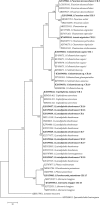Diversity and biological activities of endophytic fungi associated with Catharanthus roseus
- PMID: 30665368
- PMCID: PMC6341747
- DOI: 10.1186/s12866-019-1386-x
Diversity and biological activities of endophytic fungi associated with Catharanthus roseus
Abstract
Background: The present study involves diversity and bioactivity of the endophytic fungal community from Catharanthus roseus inhabiting the coastal region. This study has been conducted hypothesizing that the microbial communities in the coastal regions would tolerate a range of abiotic stress such as salinity, humidity, temperature and soil composition, and it may produce new metabolites, which may possess bioactive property. Therefore in the current study, the cytotoxicity and free radical scavenging potential of the fungal organic extracts have been investigated. Moreover, the apoptotic and the antioxidant potential of the fungus that exhibited the best activity in preliminary screening has also been demonstrated.
Results: Twenty endophytic fungal isolates were obtained from different parts of the plant, and identified using internal transcribed spacer region analysis. Based on the colonization frequency, the dominant genera were found to be Colletotrichum, Alternaria and Chaetomium with colonization frequency % of 8.66, 7.00 and 6.33, respectively. It was observed that the species diversity and richness was the highest in bark followed by leaf and stem regions of the plant. On screening the fungal ethyl acetate extracts for cytotoxicity against the HeLa cells, the Chaetomium nigricolor extract exhibited potent cytotoxic activity of 92.20% at 100 μg mL- 1 concentration. Comparison between the different organic extracts (ethyl acetate, chloroform, dichloromethane and hexane) of Chaetomium nigricolor mycelial and culture filtrate, it was observed that the mycelial as well the culture filtrate ethyl acetate extracts and the culture filtrate hexane extract showed significant cytotoxic potential against the HeLa and MCF-7 cells, respectively. The apoptotic- and mitochondrial membrane depolarisation-induction potential of the Chaetomium nigricolor ethyl acetate extract has also been demonstrated in this study. Further the screening of antioxidant potential of the ethyl acetate fungal extracts using DPPH scavenging assay showed that Chaetomium nigricolor extract exhibited potential activity with a significant EC50 value of 22 μg mL- 1. The ethyl acetate extract of Chaetomium nigricolor also exhibited superoxide radical scavenging potential.
Conclusion: These results indicated that diverse endophytic fungal population inhabits Catharanthus roseus. One of the fungal isolate Chaetomium nigricolor exhibited significant cytotoxic, apoptotic and antioxidant potential.
Keywords: Antioxidant potential; Apoptotic activity; Cancer; Catharanthus roseus; Chaetomium nigricolor; Cytotoxic activity; Endophytic fungus.
Conflict of interest statement
Author’s information
Dr. Geethanjali. D, FA-06, Department of Biochemistry, Indian Institute of Science, Bangalore 560,012, Karnataka, India, Email: geethadhaya@gmail.com
Dr. Kamalraj. S, FA-06, Department of Biochemistry, Indian Institute of Science, Bangalore 560,012, Karnataka, India, Email: mycolkamal@gmail.com
Prof. C. Jayabaskaran [Corresponding author], Professor and Chairman, FA-06, Department of Biochemistry, Indian Institute of Science, Bangalore-560,012, Mobile number: + 91–80-22,932,482, + 91–80-23,600,118,Email: cjb@biochem.iisc.ernet.in
Ethics approval and consent to participate
Not applicable.
Consent for publication
Not applicable.
Competing interests
The authors declare that they have no competing interests.
Publisher’s Note
Springer Nature remains neutral with regard to jurisdictional claims in published maps and institutional affiliations.
Figures





References
-
- Bacon CW, White J, editors. Microbial endophytes. CRC press, 2000.
Publication types
MeSH terms
Substances
LinkOut - more resources
Full Text Sources
Medical

